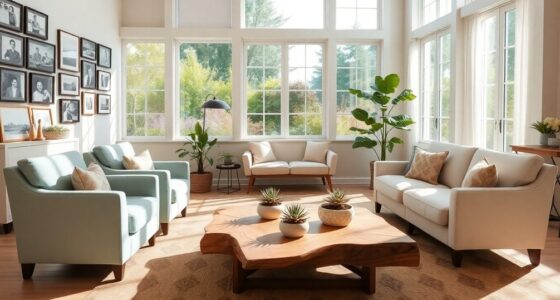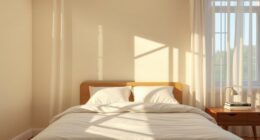To enhance senior mobility and accessibility, prioritize open, clutter-free spaces that allow safe movement. Choose ergonomic furniture with supportive armrests and lumbar support. Guarantee clear pathways and adequate lighting, including motion sensors for nighttime. Opt for slip-resistant flooring and design a senior-friendly kitchen with accessible counters and pull-out shelves. Incorporate smart technology for convenience and personalize the environment to promote emotional well-being. You'll discover even more strategies that can make a significant difference.
Key Takeaways
- Ensure clear pathways of at least 36 inches wide to accommodate mobility aids and promote safe movement throughout the home.
- Incorporate ergonomic furniture with sturdy armrests and lumbar support to enhance comfort and ease of use for seniors.
- Install grab bars and non-slip flooring in bathrooms to significantly reduce the risk of falls and improve safety.
- Utilize automated lighting with motion sensors to enhance visibility and reduce fall risks during nighttime navigation.
- Design spaces with multi-functional storage solutions to minimize clutter and create an open, accessible environment for seniors.
Prioritizing Open and Clutter-Free Spaces
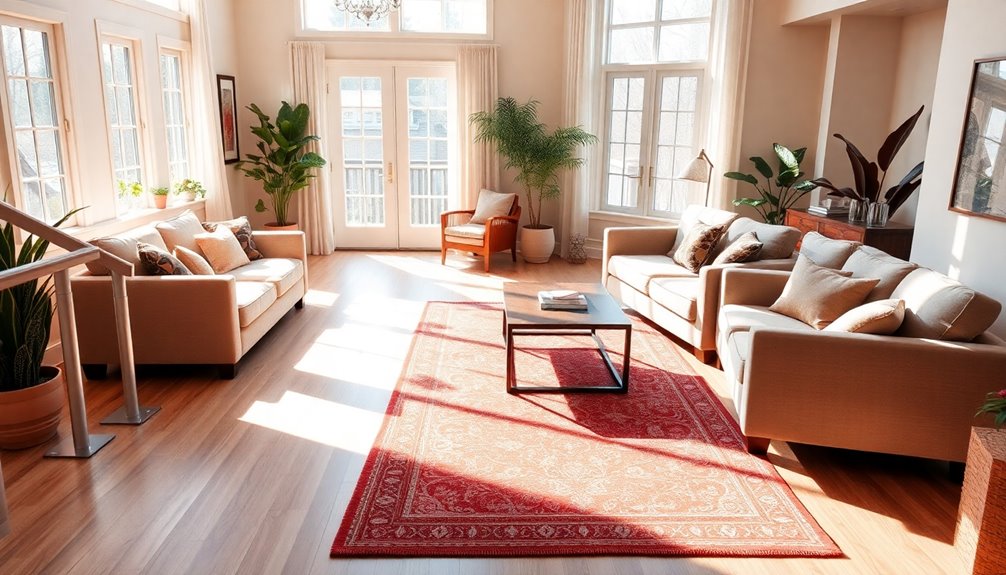
When you prioritize open and clutter-free spaces, you create an environment that makes navigation easier and safer for seniors. Clear pathways, ideally at least 36 inches wide, allow for safe movement, accommodating mobility aids like walkers and wheelchairs. Additionally, incorporating natural materials in furniture choices can contribute to a warm and inviting atmosphere.
By embracing regular decluttering, you not only enhance safety but also foster a calming atmosphere that promotes overall well-being. Defined areas for specific activities can help seniors navigate their homes more efficiently, minimizing the chances of accidents in high-traffic zones. This organization empowers seniors to access essential items independently, free from the hindrance of excessive furniture or decor. Furthermore, incorporating large indoor plants can improve air quality while adding a touch of nature that enhances the serenity of the space. Additionally, transforming spaces to accommodate the unique needs of seniors is essential for their comfort and independence. By focusing on these strategies, you support a home that encourages easy navigation and enhances the quality of life for seniors.
Ergonomic Furniture for Comfort and Support

To enhance comfort and support for seniors, investing in ergonomic furniture is crucial. Properly designed furniture not only addresses mobility issues but also promotes independent living.
Here are some key features to take into account:
- Chairs with sturdy armrests for easier sitting and standing
- Adjustable beds customized for ideal height
- Multi-functional storage ottomans to minimize bending
- Desks with rounded edges for safety and balance
- Lumbar support in chairs for better posture
These elements work together to reduce strain on joints and enhance overall comfort. Additionally, prioritizing ergonomic furniture guarantees that seniors can maintain their independence while enjoying a safe and supportive environment. Furthermore, incorporating pet therapy programs into senior care environments can significantly improve emotional well-being and reduce feelings of isolation.
Implementing mindful decluttering strategies can also create a more organized space that enhances mobility and accessibility.
With thoughtful design choices, you can greatly improve their quality of life and well-being.
Ensuring Easy Navigation With Clear Pathways

Creating clear pathways in a home is essential for seniors' mobility and safety. To guarantee easy navigation, make pathways at least 36 inches wide, accommodating mobility aids like wheelchairs and walkers.
Arrange furniture for unobstructed flow, removing barriers that could increase the risk of falls. Consider using non-slip mats in high-traffic areas, particularly near doorways and kitchens, to enhance safety and prevent slips while navigating pathways.
Multi-functional furniture can help reduce clutter, creating more open space for maneuvering. By focusing on these elements, you'll create an environment that promotes independence and confidence for seniors, allowing them to move freely and comfortably within their home.
Enhancing Safety With Adequate Lighting
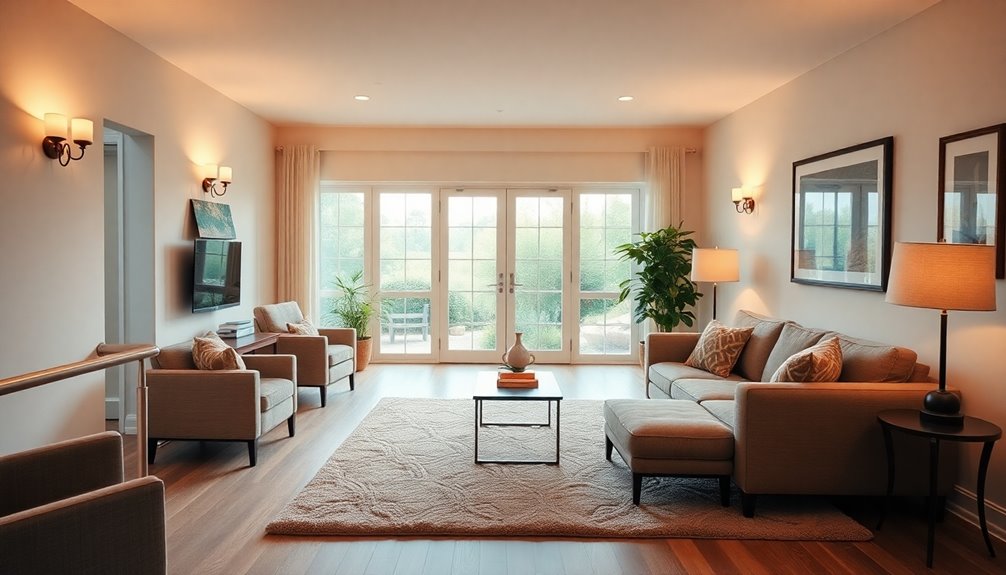
Clear pathways lay the groundwork for safe navigation, but adequate lighting is just as important for preventing falls. Dimly lit areas greatly increase fall risks, making it harder for seniors to spot obstacles.
To enhance safety, consider these strategies:
- Install motion-sensor lighting in hallways and bathrooms for nighttime accessibility. Regularly maintaining air quality can also contribute to a safer environment by reducing allergens and particles that may cause respiratory issues. Additionally, using air purifiers with HEPA filters can significantly improve indoor air quality, further benefiting seniors' health.
- Confirm well-lit entry points and high-traffic areas boost visibility.
- Use a mix of natural light and strategically placed lamps to illuminate key areas.
- Maintain consistent lighting to eliminate shadows that can hide hazards.
- Create an inviting atmosphere while keeping spaces sufficiently illuminated. Additionally, the presence of security lighting can deter criminal activity and enhance overall safety in and around the home.
Selecting Slip-Resistant Flooring Materials
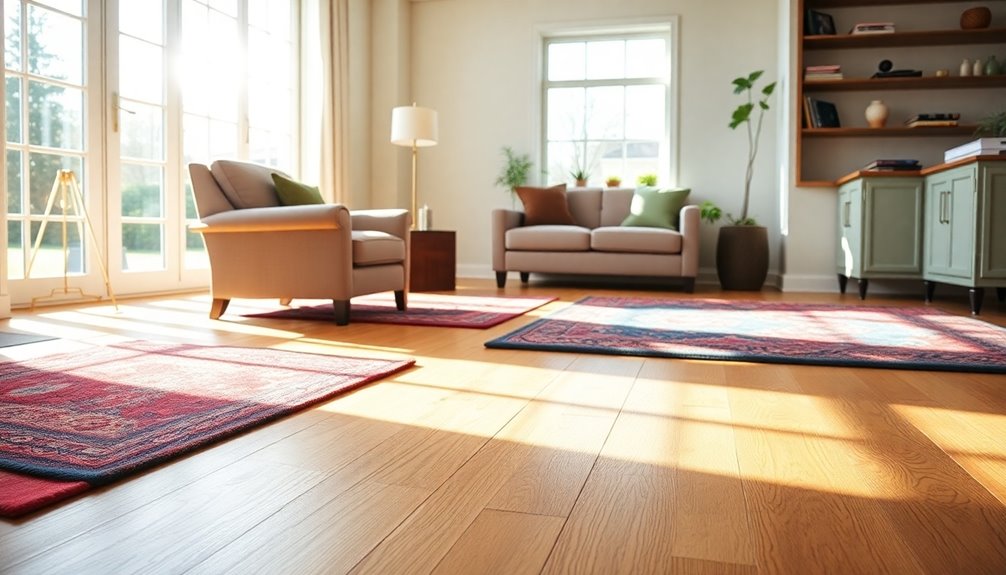
Selecting slip-resistant flooring materials is a key step. Options like low-pile carpets, vinyl, or treated hardwood can greatly reduce the risk of falls, enhancing senior mobility. The American National Standards Institute recommends a coefficient of friction of at least 0.6 for ideal safety. You can also apply non-slip coatings to existing surfaces for added grip. Regular maintenance, including cleaning and inspecting these surfaces, is vital for maintaining their effectiveness, as proper heat pump maintenance can ensure a comfortable environment while minimizing hazards. Additionally, commercial heat pumps are designed to handle larger heating and cooling loads efficiently, making them suitable for enhancing indoor comfort in senior living spaces. Make sure transition strips between different flooring types are flush to prevent tripping hazards, creating an accessible living space. Pair your flooring choice with proper lighting to further promote safety and ease in movement throughout the home. Additionally, incorporating energy-efficient heat pumps can improve overall comfort and air quality in living spaces for seniors.
Implementing Accessible Bathroom Modifications
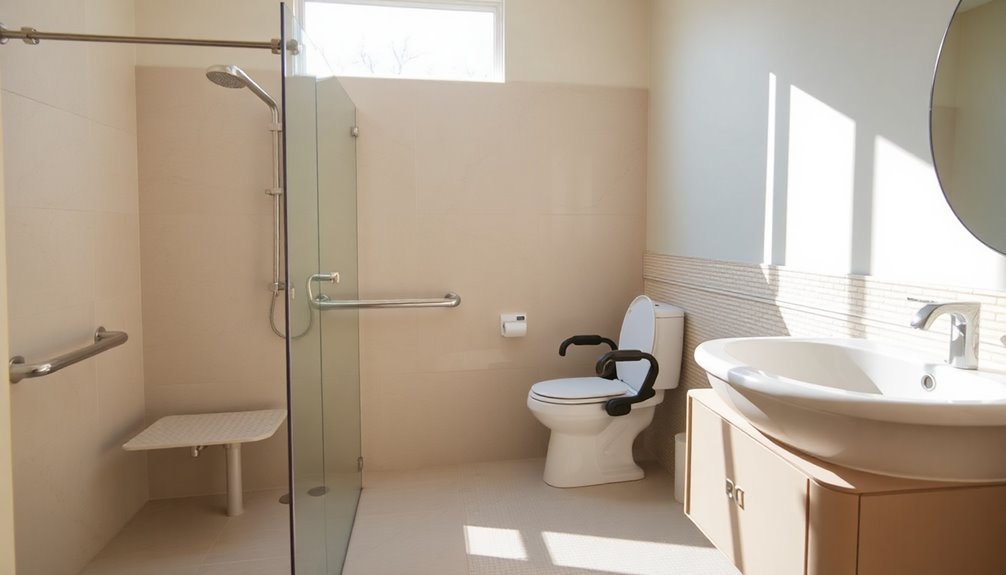
When it comes to making your bathroom more accessible, installing grab bars is a game changer for safety and support.
You'll also want to contemplate non-slip flooring options and the benefits of shower seats to enhance comfort and reduce the risk of falls.
These modifications can considerably improve mobility and independence for seniors in their daily routines.
Grab Bar Installation Tips
Installing grab bars in your bathroom can greatly enhance safety and accessibility, especially for seniors or those with mobility challenges.
Here are some essential tips for effective installation:
- Install grab bars 33 to 36 inches above the floor for ideal support.
- Use a stud finder to locate wall studs, guaranteeing secure anchoring.
- Choose grab bars with a diameter of 1.25 to 1.5 inches for a comfortable grip.
- Select non-slip materials for added safety and stability.
- Regularly check and maintain grab bars to verify they're secure and undamaged.
Non-Slip Flooring Options
After ensuring grab bars are securely installed, it's time to contemplate the flooring in your bathroom.
Choosing non-slip flooring materials like vinyl, low-pile carpets, or treated hardwood can greatly reduce the risk of falls for seniors at home. You should also consider installing non-slip mats or adhesive strips in the shower and beside bathtubs to enhance safety during bathing. High-efficiency toilets with dual flush options are also beneficial for seniors, as they provide easier access and usage. Incorporating natural materials in the design can enhance the overall aesthetic while ensuring safety.
Hobless showers are another fantastic option, as they eliminate tripping hazards and can feature textured surfaces for added traction. Additionally, opting for contrasting colors in your flooring helps seniors with low vision identify potential hazards and navigate spaces more safely. Regular maintenance is key to keeping your flooring in top shape and ensuring ongoing accessibility. Furthermore, it is essential to engage in long-term financial planning to cover any costs associated with home modifications for accessibility.
Shower Seat Benefits
Although many seniors may hesitate to modify their bathrooms, adding a shower seat can greatly enhance safety and independence during bathing. Shower seats provide a stable and secure place to sit, reducing the risk of slips and falls. By allowing you to remain seated, they help maintain dignity and ease during personal hygiene routines.
Consider these benefits of shower seats:
- Enhance safety while bathing
- Promote independence for those with mobility challenges
- Space-saving foldable or removable designs
- Complementary to grab bars and non-slip mats
- Proven reduction in bathroom injuries
Incorporating shower seats into your bathroom modifications not only boosts accessibility but also markedly improves overall well-being for seniors. Additionally, effective preventive maintenance strategies can further enhance the safety and functionality of the bathroom environment.
Designing Senior-Friendly Kitchen Spaces
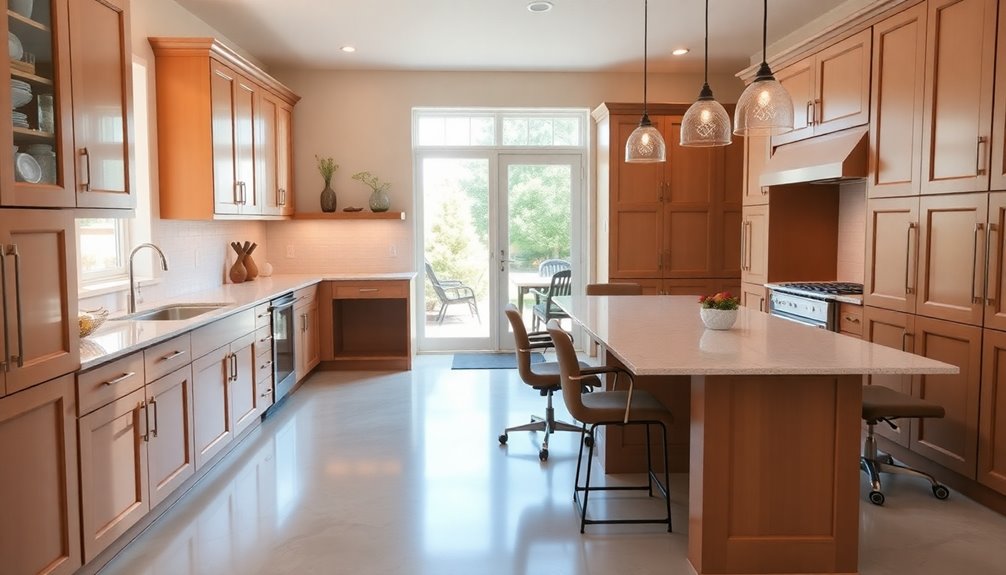
When designing senior-friendly kitchen spaces, it's vital to prioritize accessibility and safety to enhance daily living. Lowering countertops to 30-34 inches guarantees easy access for seniors with limited mobility.
Incorporate pull-out shelves and easy-to-reach storage solutions to minimize bending or stretching, promoting safer access to kitchen items. Opt for hands-free faucets and front-mounted controls on cooktops to enhance usability, allowing seniors to operate appliances with minimal physical effort.
Additionally, round edges on countertops reduce the risk of injury from accidental bumps, creating a safer environment.
Finally, optimizing lighting, especially under cabinets and near workspaces, is significant for visibility and safety, helping seniors avoid accidents while cooking and providing a comfortable living space.
Creating a Comfortable and Safe Bedroom Environment

Creating a senior-friendly kitchen sets the stage for practical living, but the bedroom also plays an essential role in guaranteeing comfort and safety.
To create a safe and comfortable home, consider these essential features:
- Choose a low-profile bed, ideally 20-23 inches high, for easier access.
- Confirm nightstands match the bed height for easy reach of essentials.
- Maintain adequate clearance around the bed for mobility aids.
- Install lighting in closets and around the room to enhance visibility.
- Incorporate familiar decor to boost emotional well-being.
Incorporating Smart Technology for Independence

Incorporating smart technology into your home can greatly enhance your independence and safety as you age. By creating a smart home, you can use voice-activated assistants to control automated lighting, thermostats, and appliances effortlessly. This ease of use promotes accessibility and encourages senior mobility.
Automated lighting systems with motion sensors can light up pathways, reducing the risk of falls during nighttime. Additionally, smart locks and video doorbells enhance safety, allowing you to monitor your entrances without getting up.
Medication reminder apps can keep you on track with your health, providing timely alerts for medications. Integrating these technologies not only fosters peace of mind but also helps you maintain autonomy while minimizing physical challenges in daily life.
Personalizing Spaces to Enhance Emotional Well-Being
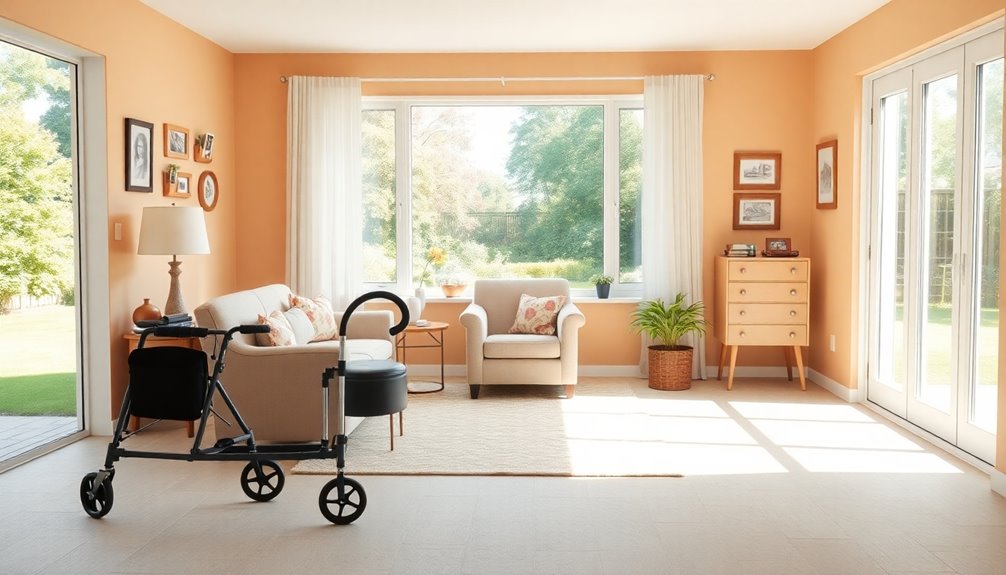
While smart technology enhances safety and independence, personalizing your living space can greatly boost your emotional well-being. By incorporating familiar decor and cherished personal items, you can create a space that evokes positive memories, fostering a sense of belonging.
Consider the following:
- Use family photos to trigger fond memories.
- Incorporate soothing colors to establish a calming atmosphere.
- Arrange personal items for easy access, promoting independence.
- Create cozy nooks that encourage relaxation and reflection.
- Design spaces that invite community engagement, enhancing social connections.
These strategies not only reduce feelings of isolation but also empower you to engage with your surroundings, ultimately leading to a more fulfilling lifestyle.
Personalizing spaces is essential for nurturing emotional health and promoting a sense of control over your environment.
Frequently Asked Questions
What Is Accessibility in Interior Design?
Accessibility in interior design means creating spaces that everyone can navigate comfortably, regardless of their abilities.
You'll find features like wider doorways, step-free entrances, and non-slip flooring that make moving around easier. It's all about ensuring safety and usability for everyone.
When you think about design, consider how intuitive layouts and flexible spaces can accommodate diverse needs, allowing people to enjoy their environments without barriers.
Embracing accessibility benefits everyone.
How to Design a Room for the Elderly?
When designing a room for the elderly, focus on creating a safe and functional space.
Guarantee doorways are at least 32 inches wide for easy access. Use non-slip flooring to prevent falls, and arrange furniture to maintain clear pathways.
Consider adjustable furniture for comfort and support, and install adequate lighting, like motion-sensor lights, to enhance visibility.
These elements will help create a welcoming environment that promotes independence and mobility.
How to Design a House for Seniors?
When you design a house for seniors, start by ensuring doorways are at least 32 inches wide for easy access.
Choose non-slip flooring to minimize fall risks, especially in busy areas.
Incorporate grab bars in bathrooms and stairways for added safety.
An open floor plan with clear pathways will make navigation easier.
Finally, install adjustable countertops and sinks so seniors can comfortably reach what they need, whether sitting or standing.
How to Design for Elderly People?
Designing for elderly people isn't just about aesthetics; it's like crafting a fortress of comfort!
You'll want to guarantee doorways are at least 32 inches wide, creating a grand entrance for walkers and wheelchairs. Non-slip flooring is a must to prevent any slip-and-slide adventures.
Think about adding grab bars in bathrooms for superhero-like support. Adjustable furniture makes reaching easy-peasy, while ample lighting banishes shadows like a knight's shining armor.
You've got this!
Conclusion
Incorporating these design strategies can truly transform a space, making it not just more accessible, but a haven of comfort and safety. By embracing open layouts, ergonomic furniture, and smart technology, you're not just enhancing mobility—you're creating a nurturing environment that celebrates independence. Remember, it's all about crafting a home that feels inviting and supportive, ensuring every moment spent there is filled with joy and ease. After all, a little thoughtful design goes a long way!



